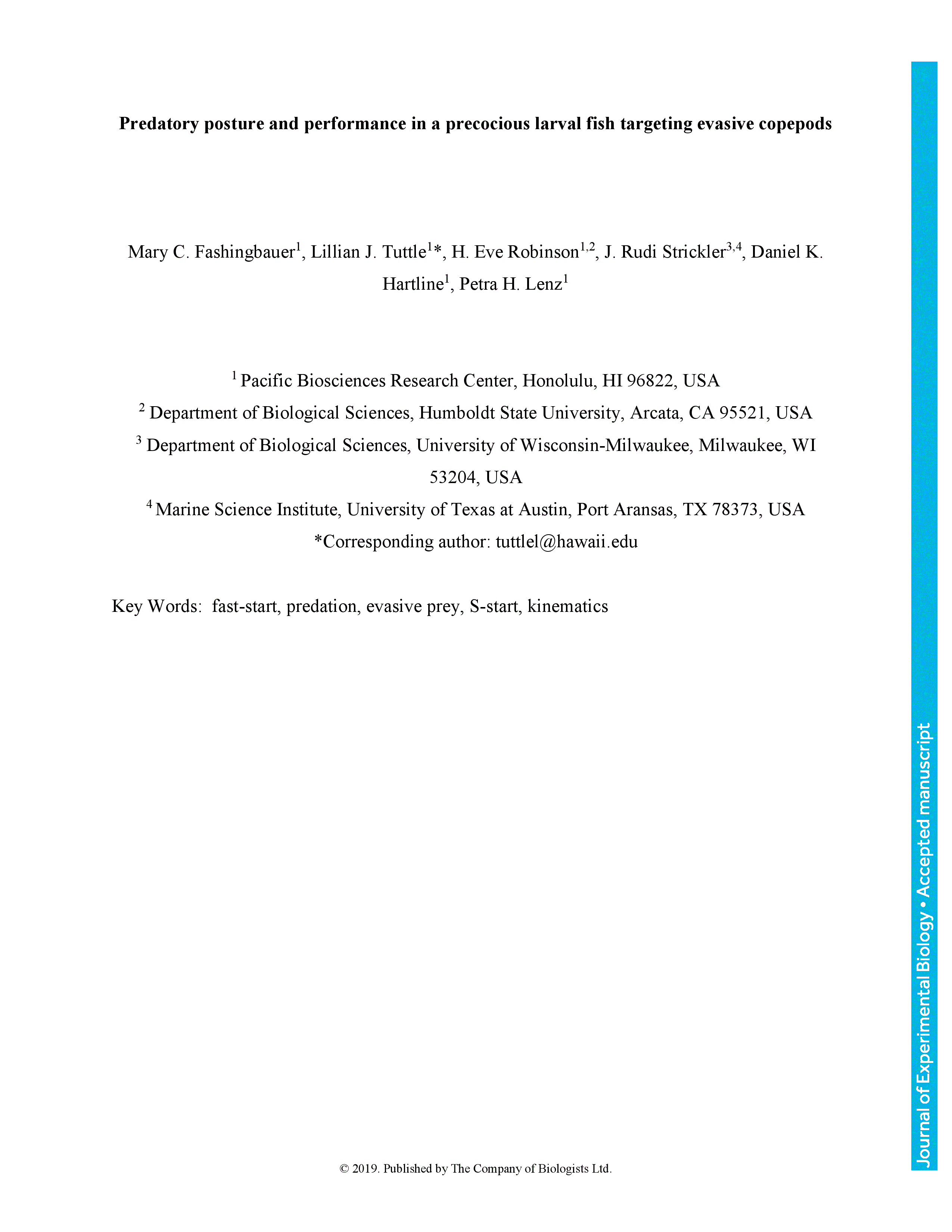Predatory fishes avoid detection by prey through a stealthy approach, followed by a rapid and precise fast-start strike. While many first-feeding fish larvae strike at non-evasive prey using an S-start, the clownfish Amphiprion ocellaris feeds on highly evasive calanoid copepods from a J-shaped position, beginning 1 day post-hatch (dph). We quantified this unique strike posture by observing successful predatory interactions between larval clownfish (1 to 14 dph) and three developmental stages of the calanoid copepod Bestiolina similis. The J-shaped posture of clownfish became less tightly curled (more L-shaped) during larval development. Larvae were also less tightly curled when targeting adult copepods, which are more evasive than younger copepod stages. Strike performance, measured as time-to-capture and peak speed, improved only slightly with larval age. Therefore, the J-posture may allow first-feeding larvae to minimize disturbance during their approach of sensitive prey, and may represent an alternative predatory strategy to the prototypical S-start.
Predatory posture and performance in a precocious larval fish targeting evasive copepods
Currently Viewing Accepted Manuscript - Newer Version Available
Mary C. Fashingbauer, Lillian J. Tuttle, H. Eve Robinson, J. Rudi Strickler, Daniel K. Hartline, Petra H. Lenz; Predatory posture and performance in a precocious larval fish targeting evasive copepods. J Exp Biol 2019; jeb.191411. doi: https://doi.org/10.1242/jeb.191411
Download citation file:
Advertisement
2023 JEB Outstanding Paper Prize shortlist and winner

The JEB Editors are delighted to announce the shortlisted authors for the 2023 JEB Outstanding Paper Prize. Read the winning paper - Tiny spies: mosquito antennae are sensitive sensors for eavesdropping on frog calls - by Hoover Pantoja-Sanchez and Brian Leavell from Ximena Bernal's lab at Purdue University, USA.
JEB Science Communication Workshop for ECRs

If you’re an early-career researcher interested in science communication and are attending the SEB Annual Conference in Prague this summer, come a day early and join the JEB Editors at a sci comm workshop to learn the key writing skills needed to promote your research to a broad audience beyond your peers (1 July at 14.30-17.30). Places are limited to 24 attendees, and applicants should apply through the SEB registration page by 30 April 2024.
Bridging the gap between controlled conditions and natural habitats in understanding behaviour

Novel technologies enable behavioural experiments with non-model species, in naturalistic habitats and with underexplored behaviours. In their Commentary, Scholz and colleagues discuss how to obtain a deeper understanding of the natural ecology and lifestyle of study animals.
Beluga metabolic measures could help save species

To help save animals from extinction, it’s important to understand what each species needs to survive. This led Jason John et al. to measure the metabolic rates of captive belugas to develop a ‘fish calculator’ showing that the whales need to eat ~23 salmon per day.
ECR Workshop on Positive Peer Review

Are you an ECR looking for tips on how to write concise, astute and useful manuscript reviews? If so, join the JEB Editors at a 2-hour JEB-sponsored Workshop on Positive Peer Review at the Canadian Society of Zoologists annual meeting in Moncton on 9 May 2024 at 13.00-15.00. There are 25 spaces for ECRs and selection is first come, first serve. To sign up, check the ECR Workshop box when you register for the CSZ meeting.



